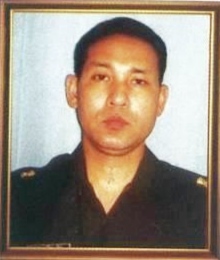Laishram Jyotin Singh | |
|---|---|
 Portrait of Maj (Dr.) Laishram Jyotin Singh | |
| Born | 14 May 1972 Manipur, India |
| Died | 26 February 2010 (aged 37) Kabul, Afghanistan |
| Allegiance | |
| Service | |
| Years of service | 2003–2010 |
| Rank | |
| Service number | MS-14522F (short-service commission) [1] MR-08609M (regular commission) |
| Unit | Army Medical Corps |
| Awards | |
Major Laishram Jyotin Singh, AC was an Officer in the Army Medical Corps of the Indian Army, who died fighting a suicide bomber during the attack on the Indian Embassy in Kabul. [2] Major Singh was awarded the Ashoka Chakra, the highest peacetime gallantry award in the Indian Armed Forces on 26 January, 2011. [3]
